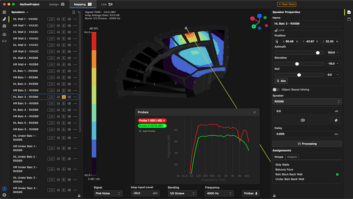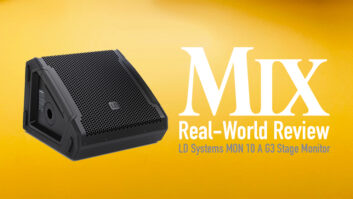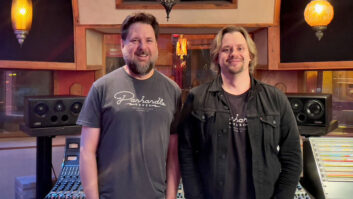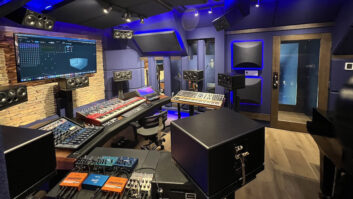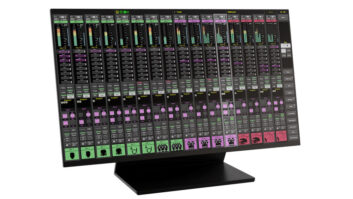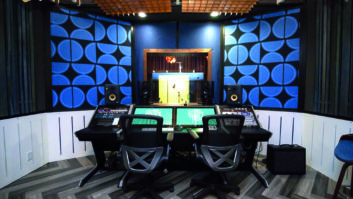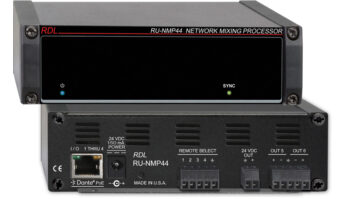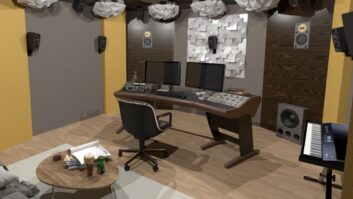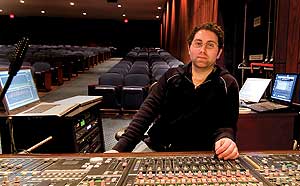
At FOH, the versatility really just continues for me. As sound engineers, we all become very familiar with the sound of those 1/3-octave centers and think of our tunings in that respect. So many times, I’ve started thinking, “I need less 800 Hz in this system” only to put a filter in at 800 and find that it’s not exactly what I was hearing. A sweep in either direction locates that problem zone at maybe 750 or 900, etc. Any parametric EQ can help achieve this but the Lake is one of the few where I can grab a tablet, sit in the audience and make my changes away from the console, which today seems to get put in worse and worse positions at venues.
—Adam Robinson

[The Turbosound Aspect] is a five-way system [on the Kings of Leon’s 2007/2008 European tour] and some of the bass speakers are being flown as part of that five-wide, five-deep to get some bottom end in the air. We’re doing this because if you are sitting off to the side of the stage and you have a cluster of speakers pointing at you, which are treble, high-mid and low-mid, it might just be a little harsh. Adding in some bass means you can feel a little pressure on your chest from the other instruments. We are experimenting as much as possible to get rid of what we call ‘power alley’ — to make the bass nice for everybody, not just a select few. A big part of it is trying to keep everything going forward, as opposed to wrapping around itself and coming up on the stage and messing with the band. I am trying to shake the body of the person that is in the back of the arena without affecting the band.
—Brent Rawlings

One desk does the A stage and the other desk does the B stage, but both can feed either P.A. That’s because there is a point in the show where I am pulling inputs from the A stage and feeding them through the B stage P.A., at the same time as inputs from the B stage are also feeding its own P.A. Dave [Grohl] plays on the B stage by himself with his A stage electric guitar, so his wireless system feeds the receiver and inputs on the A stage. However, he’s singing into the mic on the B stage, so I’m pulling the guitar signal from the A stage and feeding it through the B stage P.A. with his vocals. Halfway through, the rest of the band kicks in on the A stage, so I bring in the A stage P.A. and kill the B stage P.A. There is a lot going on — almost 90 inputs, and it’s quite complicated — but it works out really well. You just need to get your head around making it happen. The crowd goes crazy because they’re all looking at Dave on the B stage, and all of a sudden it gets big and loud behind them. Working from two consoles is much less confusing than doing it from one, which is what I tried to do before and it didn’t really work out.

Some newer arenas seem to be very bright, with lots of reflective surfaces, from skyboxes, etc. How should I deal with an overly live venue?
Modern line array technology offers the best way to deal with highly reflective, reverberant large spaces. Here, it’s best to fly the array as high as possible, aiming the majority of the cabinets downward to minimize the “slapback” effect. It’s also important that each cabinet is vertically splayed. A flat array in the vertical plane will send too much energy toward reflective areas such as skyboxes and wall surfaces. If properly hung, the wide dispersion of acoustical energy in the horizontal plane and tight pattern control in the vertical plane will make for surprisingly good results in what have traditionally been difficult venues.
—David Morgan

In large halls and arenas, line array systems can help achieve even front-to-back SPLs and frequency response. Here’s a tip for smoothing level and tonality when using ‘old-school’ systems; i.e., horizontally arrayed columns of speakers. Assuming the system can be divided [electronically] into a top [long-throw] and bottom [nearfill] cluster, start your tuning process by balancing and EQ’ing only the top section along with the sub-bass and get that right at the back of the hall. Once that’s done, blend in the lower section of speakers [usually at a lower volume and smoother EQ] to make up for what’s missing up front.
—Jim Yakabuski

A well-known living legend once advised: ‘Listen. Listen to what’s coming out of your speaker.’ I listen to events in the room during the course of the day. When I enter the building, I grab some coffee, go to where I’ll be mixing — and elsewhere — and I listen! What room effects do the forklifts cause when they drive by? What does it sound like when lighting guys are banging truss? All of these give you an indication of what the room will sound like or what you may be trying to correct when you excite it with thousands of watts of your ‘art.’ Regardless of what wondrous tools you have, at the end of the day, you must take the room on its terms — not yours!
—Monty Lee Wilkes

I use SpectraFoo in my usual mode to EQ the system and get it tied in together properly. [On a recent corporate gig], I took about three or four frequencies out — just minute slivers. I gained 6 or 8 dB of headroom as compared to doing it with a graphic equalizer. I got better end results without crucifying the audio system. I have it set on continuous resolution so it’s very accurate, but you often find engineers who aren’t used to looking at that kind of display. For the show, I’ll put it into a different set of windows or a different set of resolutions that the engineer can read very easily.
—Mark Ballard

When mixing a loud band in a small club or theater, time-aligning the main P.A. speakers to the backline can focus your mix’s low end. Even modest venues provide drive processors at the mix position that incorporate delay on the main outputs. Measure the distance (in feet) from the backline directly downstage to the P.A. mains’ “acoustic center.” Multiply this distance by 0.9 (the speed of sound in air at 70 degrees is just under 1 foot per second), which results in the number of milliseconds of delay to “dial in” on the processor. This small delay — typically ranging from 15 to 30 milliseconds — will hold back the P.A. speakers for sound from the backline to catch up. This helps avoid cancellation of low frequencies due to the instrument amplifiers being acoustically out-of-phase with the P.A.
—Steve La Cerra
You can create happiness for the musicians onstage by using what already exists in your environment. Before deciding where to set stage levels, listen to the P.A., the room’s characteristics or the amount of lower frequencies that spill out the back of the subs and onto the stage. The FOH systems engineer may back up the left and right or the subs alone. This is stealing some of what’s used out of the house system to use for feel and air movement onstage. I think of what can happen to create level spikes. I always have pads out on mics and channels. If a pad gets bumped or fails, the input lowers as opposed to raising 15 dB or so. A good hard-knee peak stop limiter or the legendary Aphex units in-line can save a person’s hearing and your job.
—Kevin Glendinning

The center of the stage is off-center in relation to the center of the seating area, and both are off-center relative to the center of the room. This means there isn’t a “center” from which to plot a traditional system design. We got the plumb bob lasers out, we made calls to double-check the [Electro-Voice] EASE data and we made a ton of chalk marks on the floor. Finally, we shot the room with lasers, and then got out two pieces of string. After using a balance of high-tech software and simple geometry, we did a sweep of the room from front to back with the string, and where the two crossed was our center. As additional insurance, each main array grid features a custom rotateable yoke, allowing for easy, non-Sheetrock-invasive aiming adjustments.
—Greg Mace

The real-time analyzers most touring vendors send out are simple LED units with few features or functions — not much help if you want to measure the room in 20 different spots and save 20 different presets of what the room looks like. I use [Metric Halo’s] SpectraFoo, which can re-create a third-octave — style analyzer, but being software-based, it can memorize as many snapshots as I want. I can also send my console solo cue bus to it and use SpectraFoo’s phase scopes. For interfacing several sources from my console to a laptop (which lacks multiple inputs) to run SpectraFoo, I use [Metric Halo’s] Mobile I/O. This turns your laptop into a miniature console, with eight analog I/Os, and AES and S/PDIF digital I/Os. With that setup, you have a little matrix mixer and everything a console would have, except there’s no surface.
—Sean Sullivan
Learning to mix from a bad mix location, such as way off-center or under a balcony, is difficult. Here, you need strong faith in your decisions. Hopefully, you had time to listen to the P.A. from a good spot before the show. After adjusting the P.A. to your taste, trust your previous decisions while listening to less-than-perfect audio. This is a good case for carrying SIA Smaart or some other system that will verify the correlation between your mix out of the desk and a test mic placed in a “good” listening position. I also carry a pair of trusted near-field monitors (Tannoys). After delaying them to the P.A., I use them at the least-perceptible volume to fill in what I can’t hear from the main system. This is a luxury solution, but I can depend on them in problem venues. And remember, the house sound person is your friend. Accept constructive help if you can’t hear the P.A.
—David Morgan
PLAY:
Tell us your tip
